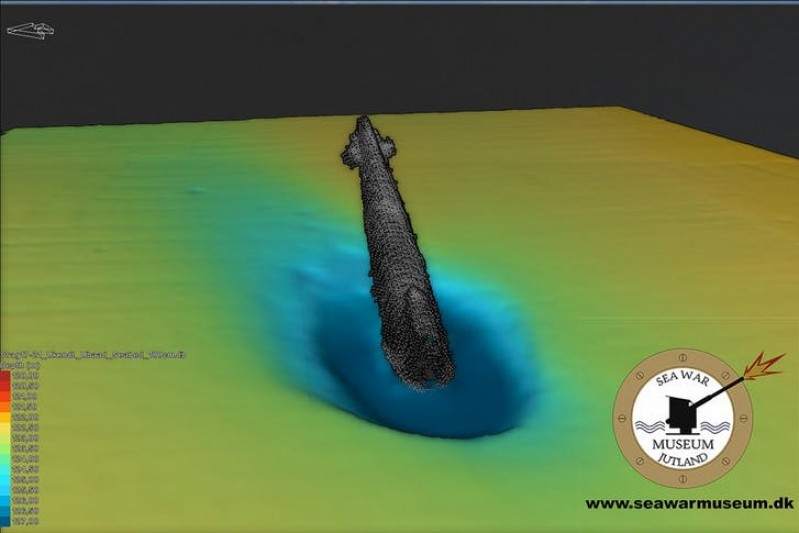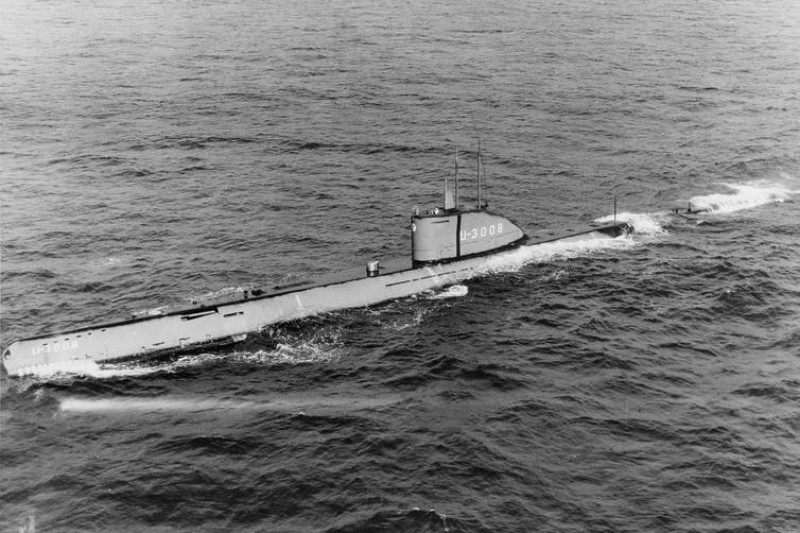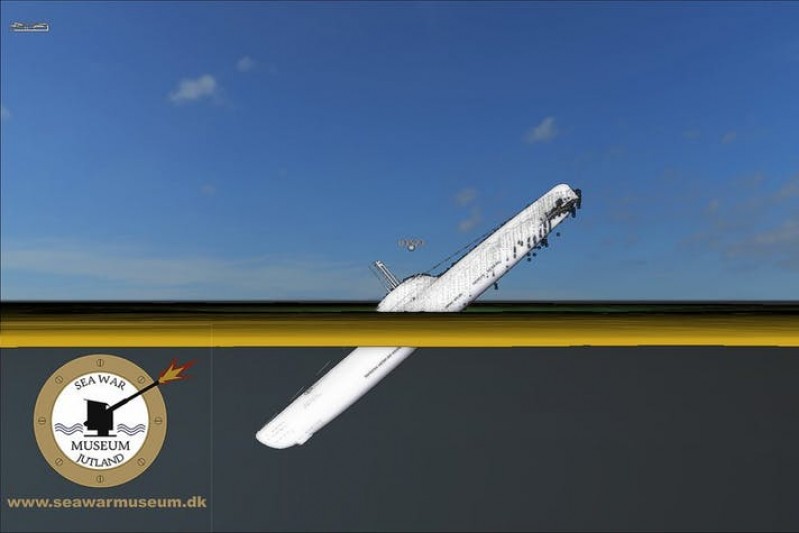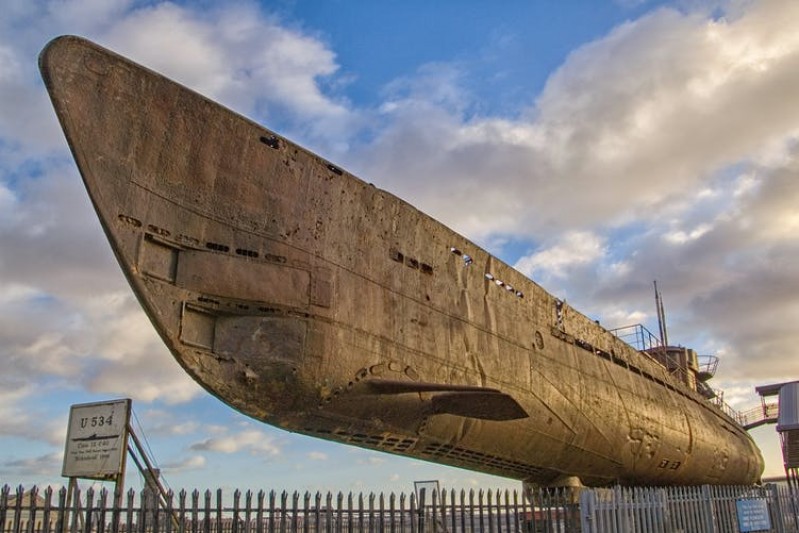By Innes McCartney, Bournemouth University
 [Above image] Sea War Museum
[Above image] Sea War MuseumThe collapsing Nazi government ordered all U-boats in German ports to make their way to their bases in Norway on May 2, 1945. Two days later, the recently commissioned U-3523 joined the mission as one of the most advanced boats in the fleet. But to reach their destination, the submarines had to pass through the bottleneck of the Skagerrak – the strait between Norway and Denmark – and the UK’s Royal Air Force was waiting for them. Several U-boats were sunk and U-3523 was destroyed in an air attack by a Liberator bomber.
U-3523 lay undiscovered on the seabed for over 70 years until it was recently located by surveyors from the Sea War Museum in Denmark. Studying the vessel will be of immense interest to professional and amateur historians alike, not least as a way of finally putting to rest the conspiracy theory that the boat was ferrying prominent Nazis to Argentina. But sadly, recovering U-3523 is not a realistic proposition. The main challenges with such wrecks lie in accurately identifying them, assessing their status as naval graves and protecting them for the future.
U-boat wrecks like these from the end of World War II are the hardest to match to historical records. The otherwise meticulous record keeping of the Kriegsmarine (Nazi navy) became progressively sparser, breaking down completely in the last few weeks of the war. But Allied records have helped determine that this newly discovered wreck is indeed U-3523. The sea where this U-boat was located was heavily targeted by the RAF because it knew newly-built boats would flee to Norway this way.
Identification
The detailed sonar scans of the wreck site show that it is, without doubt, a Type XXI U-boat, of which U-3523 was the only one lost in the Skagerrak and unaccounted for. These were new types of submarines that contained a number of innovations which had the potential to make them dangerous opponents. This was primarily due to enlarged batteries, coupled to a snorkel, which meant they could stay permanently underwater. Part of the RAF’s mission was to prevent any of these new vessels getting to sea to sink Allied ships, and it successfully prevented any Type XXI U-boats from doing so.
 The Type XXI U-3008. Wikipedia
The Type XXI U-3008. WikipediaWith the U-boat’s identity correctly established, we now know that it is the grave site of its crew of 58 German servicemen. As such, the wreck should either be left in peace or, more implausibly, recovered and the men buried on land. Germany lost over 800 submarines at sea during the two world wars and many have been found in recent years. It is hopelessly impractical to recover them all, so leaving them where they are is the only real option.
Under international law all naval wrecks are termed “sovereign immune”, which means they will always be the property of the German state despite lying in Danish waters. But Denmark has a duty to protect the wreck, especially if Germany asks it to do so.
Protection
Hundreds of wartime wreck sites such as U-3523 are under threat around the world from metal thieves and grave robbers. The British cruiser HMS Exeter, which was sunk in the Java Sea on May 1, 1942, has been entirely removed from the seabed for scrap. And wrecks from the 1916 Battle of Jutland that also lie partly in Danish waters have seen industrial levels of metal theft. These examples serve as a warning that organised criminals will target shipwrecks of any age for the metals they contain.
 Detailed sonar scans have been taken. Sea War Museum
Detailed sonar scans have been taken. Sea War MuseumGermany and the UK are among a number of countries currently pioneering the use of satellite monitoring to detect suspicious activity on shipwrecks thought to be under threat. This kind of monitoring could be a cost-effective way to save underwater cultural heritage from criminal activity and its use is likely to become widespread in the next few years.
Recovery
The recovery cost is only a small fraction of the funds needed to preserve and display an iron object that has been immersed in the sea for many years. So bringing a wreck back to the surface should not be undertaken lightly. In nearly all cases of salvaged U-boats, the results have been financially ruinous. Lifting barges that can raise shipwrecks using large cranes cost tens of thousands of pounds a day to charter. Once recovered, the costs of conservation and presentation mount astronomically as the boat will rapidly start to rust.
The U-boat U-534 was also sunk by the RAF in 1945, close to where U-3523 now lies. Its crew all evacuated that boat, meaning that she was not a grave when recovered from the sea in 1993 by Danish businessman Karsten Ree, allegedly in the somewhat incredible belief that it carried Nazi treasure. At a reported cost of £3m, the operation is thought to have been unprofitable. The boat contained nothing special, just the usual mundane objects carried on a U-boat at war.
 U-534 after the rescue. Les Pickstock/Flickr, CC BY
U-534 after the rescue. Les Pickstock/Flickr, CC BYSimilar problems were experienced by the Royal Navy Submarine Museum in the UK when it raised the Holland 1 submarine in 1982. In that case, the costs of long-term preservation proved much greater than anticipated after the initial rust-prevention treatment failed to stop the boat corroding. It had to be placed in a sealed tank full of alkali sodium carbonate solution for four years until the corrosive chloride ions had been removed, and was then transferred to a purpose-built exhibition building to protect it further.
The expensive process of raising more sunken submarines will add little to our knowledge of life at sea during World War II. But each time a U-boat is found, it places one more jigsaw piece in its correct place, giving us a clearer picture of the history of the U-boat wars. This is the true purpose of archaeology.
Innes McCartney, Leverhulme Early Career Fellow, Department of Archaeology, Anthropology and Forensic Science, Bournemouth University
This article was originally published on The Conversation. Read the original article.



